
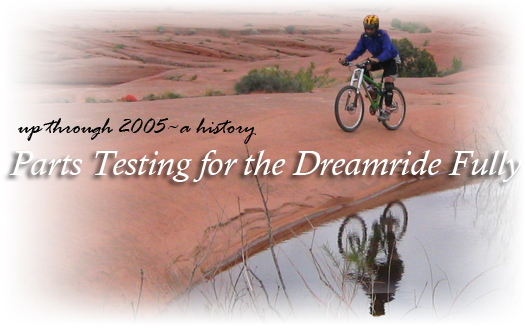
CURRENT PARTS EVALUATIONS | DREAMRIDE FULLY SALES | DREAMRIDE MUTANT SALES
Refined Gusseting for Individual Rider Weight/Height and Suspension Travel Setting
Fit and Geometry
Fork Geometry and Axle Choice
Testing Evolution, Past to Present
The greatly abreviated verdict on the Maverick fork.
Adding the Fox DHX and the Marzocchi AM-1 (read the DHX-Air update below)
After a long period of testing, the Marzocchi AM-1 or AM-SL are preferred forks for the Fully. The AM-1 made me even more excited about my Fully, which now wears the Fox DHX-Air, cementing that particular shock as the stock item for the bike. My Fully was completed with the addition of a custom Moots stem (I spoil myself), a beefier wheelset and the DHX-Air. Now, I can honestly say that this bike is definitely my favorite of all time. I own twelve bikes that I "try to" ride, including a selection of Moots suspensions and quite a few Ventanas. The Fully has become the bike I grab if the shop burns down around me. I might even grab it before I grab my National lap steel guitar and that is saying something. I can replace my Fully. When I choose a bike to ride with ANY client, I choose the Fully, despite the fact that I can go with a much lighter Moots Cinco or Smoothie for more moderate trails. Even on those moderate trails, I prefer the Fully. It is that good because it is more efficient. Since the weather has been insanely hot this summer, I have been riding singletrack and 4WD roads in the mountains for training. At first I was riding the Moots Cinco (27 pounds), but now I ALWAYS take the Fully (currently 30.7 pounds). I have recently built Fullies for other clients, such as the blue one at the top of this page, that weigh under 29 pounds. On average, over all trail surfaces and grades, it is WAY faster, a ton more comfortable, stupid safe, and it handles technical sections of trail with much more confidence. So, here it is, the 6" travel XC/All Mountain rig we have all been looking for. Pony up.
Titanium parts!
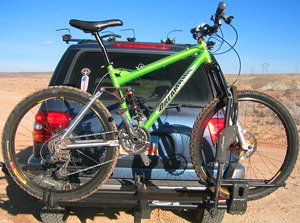
Here is the Fully's background, in brief:
The Dreamride Fully has been in development since 1996 when working as a stunt coordinator and location scout in Moab, Utah I found that there was not a single bike available under 40 pounds that would hold up under the abuse necessary for film stunts. While coordinating the mountain bike segment of the IMAX film, EVEREST, which I knew could revolutionized the concept of what is possible on a mountain bike, I hired good stunt riders and worked with a small manufacturer to put together pedaling "freeride" bikes that could take a beating and still work "like" XC rigs, at least as long as the shot goes, anyway---those bikes weighed 42 pounds, by the way. In 1998 I hired Nathan Toone, 4-time Utah State Downhill Champion, to guide, teach and do stunts for Dreamride. I watched as he invented the art of slickrock freeriding, and in his case, turning it into an art form. If you see the picture of him dropping the Mushroom for the first time in history, realize it took a solid week to build, test, rebuild, test, rebuild and finally on-site test and jump the bike for that picture. A stunt like that had never been done before. The photo and stunt are now copied repeatedly in magazines, performed for the cameras by riders far less talented than Nate for companies with more money invested in marketing than product. It took a lot of nerve and courage to be the first, and, as we now know, Nate could have done it with lesser equipment, . . . BUT we didn't know that then. Every day our tour company puts equipment through far more forces than Nate encountered on that drop. Safety demands state-of-the-art equipment, first. In our job it is a necessity to work toward an efficient and rugged mountain bike. Necessity is the Mother of Invention.
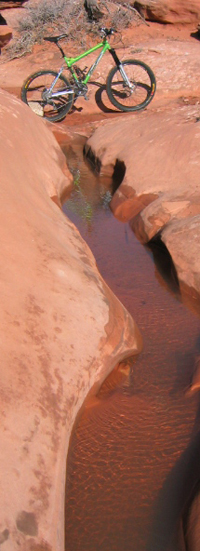
Let's call the Fully a trailbike.
"NBS" suspension is exactly what you think it is. If you have read reviews and suspension evaluations posted on this website over the years, you know the evolution of the Fully and Mutant. Past associations were fruitful, disappointing and a pain in the ass. You should know that the "Dreamride Moment" is when rainbows and sunrises happen at the same time on the trail for clients who deserve a sacred "Moment." It is what we have been calling the magic we do as a tour company over the past ten years. Our clients know that and they can see what is going on! The fact that the name was stolen should tell you just what kind of "quality" the bike with that name possesses. There are other bikes out there that wear the mark of Dreamride testing and development, but there are good reasons we do not endorse them. The prime reason, lateral flex. The Ventana rear ends surpass all others in this department while maintaining pedal effiency, and it doesn't have an alphabet soup patent based on a stolen idea.
Our clients don't mind waiting to get the ultimate fast bike. It takes four to ten weeks to get a Fully, which is not bad compared to other full custom bike shops who just use stock frames anyway. Our frames are custom made! My own Fully took 5 weeks to get the frame into our shop for completion of the build. It usually takes me three days to build a Fully or a Mutant. Because my rig is the test platform for parts worthy of consideration, it took six months to perfect the final build. As of September 2005, the parts for our 2006 kits are finalized, and man, do they deliver a fast, safe bike.
The bike reviewed here is my personal guide bike, the one I guide with in Utah, Colorado, Hawaii and on the Navajo Reservation. I use it for training and I have ended up taking it just about everywhere I go, forgoing use of most other bikes I own. I can honestly say that since I have my Fully and Mutant bikes, I don't ride anything else off-road. If I ride my Mutant to guide on, the client better have a Mutant, because I am going to ride away from him just to get the bike to the speed where it works efficiently. So, the Mutant is dangerous. The Fully, on the other hand, is simply a very cushy trail bike with quick handling and stability at speed. The Mutant jumps. The Fully doesn't. The green Fully in this review, a late 2004 model, has become my favorite bike of all time. It took a while to make it perfect, but even when it wasn't perfect it was better than anything else I have ridden in its weight range, and a hell of a lot faster.
To begin testing I installed a customized Manitou Supernova fork and the same proven parts from a long travel El Salt I rode the year prior. I purposely rode trails on the Fully where I had tested the original El Saltamontes with that same fork and build. This helped me to be able to understand the limitations of that frame and design in fix-its for the problems I could find, like seat tube gusseting allowing more standover for longer travel and a much stronger front triangle. The original test component kit was stock SuperEgo with an XDT fork/axle upgrade. Later I swapped the Supernova fork for a 2004 Marzocchi Freeride SL. I still like the Supernova, but it is a throwback and useless for clients. Throughout 2005 parts were dropped, recombined and the fork choice became clear.
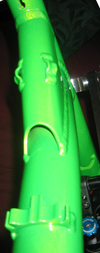
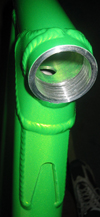
The seat tube gusset was originally fabricated for the Fully in late 2004 to lower standover. The gusset did more than that, stiffening up the frame to a great extent. The cable routing goodies that adorn the seattube gusset were refined during the spring of 2005 along with new cable guides for the top tube. We keep them on top for for all sizes, hence the cable zip tie binders that transfer the cables around the seat tube with absolutely no rubbing on the paint. I like the clean lines and direct flow of the cable. In late 2005, Fullies spec'd with 6" of travel for riders over 170 pounds started getting overlap gusseting on the underside of the headtube/downtube junction and a beefier straght gauge downtube. Riders under 170 can opt for double butted tubing without the downtube gusset on either a 5" or 6" Fully. Those under 170 pounds may also eliminate the seat tube gusseting for a weight savings (smart for racers). The gusseting is just one more area of the Dreamride Fully that demonstrates personalized tuning we do for each and every client.
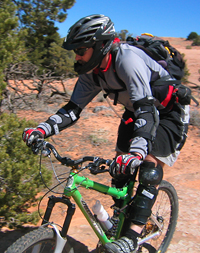
There is a three degree range in seat and head angles that allows us to tune each Fully for specific use and the rider's specific skills and terrain needs. The test bike fits me like a glove and has the steepest frame angles I could sanely use. I appreciate its quick handling abilities and intimately understand its limitations and advantages. The steeper angles mean a shorter wheelbase, which works for me for the bike's intended use--guiding. You too, can have your personal Fully spec'd with steep angles at 6" of travel, but I do not recommend such a short wheelbase, tall bb height or steep head angle to most others, unless their trails are like the ones I ride and their skills and needs are similar. Only 10% of clients end up with the steeper geometry. Everyone who gets on my bike is amazed at the striking difference between their crate-bike and my personal Fully. All profess that the Fully is a fantastic handling machine set for expert riders who use body english through rough stuff. For me, like all Fully owners, its performance suits my riding style because that is how and why I built it. The steep-ish head angle and high-ish bottom bracket came together well with a de-tuned 6" Marzocchi fork and XTR 180mm crank arms. It is a strange bike by current standards of geometry, but it works for like a charm for me, and those I have spec'd the same geometry for have raved about it. Those riders are generally from Arizona, New Mexico or Utah. Others may like the feel when they throw a leg over and ride around for a while, but most of the time I will insist on slacker angles for more stability, a slightly lower bottom bracket and longer wheelbase, especially for east-coasters. As I have said, this test bike insists on slight weight changes in situations where the bike's quick handling shines through. This can be extremely rewarding and efficient, or it can bite you in the ass.
This bike was designed around taller 150mm forks for "all mountain" use. The Z-1 Lite, AM SL and AM-1 forks are certainly perfect for the straight up six inch travel rear end. Every Fully built in 2004 was designed for the specific fork height of a 5" travel fork. From 2005 on, 6" Fully bikes get a true 6" fork. Hence more headtube gusseting that does not appear on this test bike.
I construct conversion kits for the Fully just as I do for the El Saltamontes, but there is so much travel adjustment on this bike from the saddle and off the bike that a conversion to five inches is truly unnecessary, unless you are converting for weight reduction. The Fully uses an adjustable rocker -- 5 or 6 inches of rear wheel travel. You can adjust front travel from 110mm to 130mm or 130 to 150mm with a shock pump and/or the twist of a knob (the decision on overall fork travel is made during the consultation). My personal preference for bolt-on axles sent me down a long road of testing throughout 2005. A bolt-on axle is more about safety more than anything else, but it is also about handling. As a guide, the safety issue is prime. I am always thinking about everyone else's bike. I need my personal bike to be rock solid without thinking about it. A 20mm (or larger) front axle usually means more weight to compensate for additional speed and the stress it puts on the bike, but more than anything, it's a braindead safety measure that eliminates a dangerous quick release on a wheel with a 7" brake rotor.
The most popular fork choice for the Fully--the Marzocchi AM SL--has amazing valving--seemingly infinite tunability based on modifications of simple, solid valving designs of previous forks. But, as of early 2005, there was no option for bolt-on front axles without going for a heavier Z-150 FR model (complete coil spring design). In 2006 this has changed, but the road I took in testing put me on a course away (and back to) Marzocchi for a while. I used a 2004 Z-1 FR SL 150, a rare bird with a lock down feature and five positions of valving--of which I used three. It has a negative air chamber that can adjust ride height. This is NOT its intended use, but it works, anyway, then later it blows a seal and requires an upgrade to more beefy seals from the factory. A fact of life. Newer 'zocchi forks have a beefed up negative air chamber with a fancy sticker (the same deal, just with marketing bullshit alphabet soup labels), plus external rebound and a five position clicker that further tunes over-all ride quality. (The AM-1 that ended up on this bike locks down into a shorter travel that works great on climbs and still works on the flats when you want a quicker front end of around 72 degrees.) When air pressures are set correctly, all of these forks spoil you rotten. They are solid, stiff and plush with nearly bottomless travel. AND, these forks are reliable, without maintenance worries over long periods of time. Which, by the way, suits everyone's needs. Sure, there are other forks that may feel as good at one point in their lives, that have better marketing appeal, that look gnarly or different, but Marzocchi's feel good year-round and for years to come and they are beautiful. Marzocchi's quality, incredible reliability and almost non-existent maintenance schedule is legendary. Customer service may be lacking at times, but the Italian-made product is nearly flawless. We test a lot of forks and Zokes always come out on top. The Fully's construction stands up to that Zoke reputation, putting the cake firmly under the cherry.
If you want to read the evolution of this bike's development from way back in 2002 and 2003, go to EL SALTAMONTES TESTING. Testing info on Smellsworthless stickered bikes have been removed to keep the Truth from you. As I have said already, the custom red El Saltamontes bike in original testing (my previous guide and scouting rig) had nearly identical geometry and a similar feel when compared to the green Fully in this test. The wheelbase of this Fully is a tad longer, the travel a tad longer, and the bottom bracket a bit higher. The Fully is definitely stiffer. The green bike (see the bottom of the page for current picts and descriptions) is head and shoulders above any other bike XC or All Mountain rig I have ever ridden, no shit, no kidding. Just ask those who ride with me, or who own one! At my age I need every advantage I can squeak into the build and the Fully gives me an edge over every terrain I ride, here, in Hawaii, in Colorado's mountains and on the rez. For example, because the weight of the Fully has been reduced, I no longer ride my Moots Cinco because the Fully kicks its ass in EVERY situation. The only reason for anyone to choose the Cinco over the Fully is because the titanium might get you laid and the bike will be easier to put on a roof rack. My Fully does wear Dreamride titanium, however. We now have our own ti bars and bar ends that can come with the package, if they suit your needs.
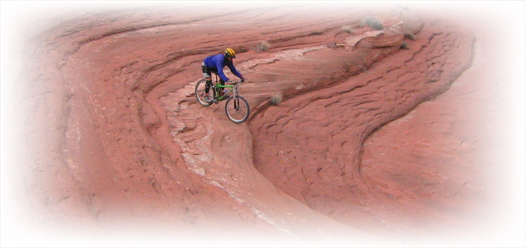
The Maverick American DUC 32 Disaster:
A fork for the Darwin Awards.
In a nutshell: This product failed the test miserably. If you are a very light and smooth rider, it might work for a while, but if you are NOT a pussy, don't go there. The Maverick DU32 fork caused a stir worldwide. In the lazy, money grubbing, ad-filled, bribe-driven magazines, it gets five stars. On the trail, this fork falls apart rapidly, and then you might see a lot more than five stars. There has been no recall that I know of, but if your fork has serial numbers on the dropout, don't ride it. If it has the serial number elsewhere it is still be a danger to you, if you ride it hard. If your Maverick fork broke, and you didn't get hurt, take pictures, call Maverick and arrange to send it back. At a minimum ask for your money back, NOT a new fork--ask for money. If the fork has hurt you, do NOT send it back. Your insurance company is going to want to see it, especially if your injury (or death) is "serious."
The full review of the DUC was updated and finalized on June 1, 2005, then placed in the DSE files behind passwords due to a threat in the form of a casual, "What goes around, comes around" from Maverick. Ah, Boulder, the concept of Karma, the center of the world of shit. Instant karma is when your fork breaks. The truth might hurt sales, but this fork will hurt you even worse, first in the wallet, then elsewhere. This light weight XC fork masquerading as an all mountain or, God forbid, freeride toy, gets the award for "Most dangerous mountain bike component of 1995." Everyone who sees it remarks on how beefy it must be, but this perception is opposite to reality. The fork is a designer's dream, but a rider's nightmare. If the single air chamber blows (and it has been known to blow), it collapses, and you can imagine what happens next. Oil leaks are standard fair--and brakes don't work on an oily rotor. The fork I purchased had loosening top clamps due to a known flaw in manufacture (threads were not deep enough for the bolts). Scary overall flex happens at high speed and over extremely rough rock moguls (too light for prime time). Failure will happen if you ride it like a 6" travel fork. There are lots of issues with installation and maintenance that I will not pass along. It is too expensive to install aftermarket due to all the things you are going to have to replace to make it work. The brake mounts on my fork only fit Hope Minis--really stupid. The freaky fork dive reminds me of the Girvin J-stroke nightmare. "Long travel" describes what happens when you take it to the front door and fling it as far as you can. The Maverick DUC32 is so light that you can get good distance with relatively little effort. Ah,now that is "efficiency."
Here is my free advice to the manufacturer that I probably shouldn't give, considering the fact that I paid a fortune for a test fork and eventually just threw it away and my advice is worth twenty times more than I paid for the fork: Ditch the air chamber as primary spring. Put a titanium coil in there and an air preload assist--your price-is-no object-clientelle won't care if the fork costs $2K. Lower the travel to five inches to reduce dive or make the fork an inch or so taller, and increase overall strength by making the aluminum box and stantion walls thicker. Beef up the dropouts in every regard! Thicken and raise the bottom headset race a quarter of an inch as a safety stop should the headset or top crown loosen on a ride. Get the details right BEFORE you sell another new product. Forget the stupid weight savings and build something strong that works as well as a Marzocchi. Sometimes I wonder why weight is such an issue to cyclists. Americans are so fat, why do we have to accept Twiggy as our model for bike equipment?
The Fox DHX series is current state-of-the-art in rear shocks. The process of shock choices evolved as such: The Romic originally mounted on this bike was suited to work with a Marzocchi fork, but when the Maverick was added, the rear felt squishy and seriously imbalanced, so I decided to go with a Fox DHX-5, which is much more adjustable--it could be more firm. Adding this shock to the Fully soon made me rip the Maverick off the bike and replace it with the 150mm AM-1, which balanced out the DHX very nicely indeed. As it turns out, the only benefit of installing the Maverick was that it forced me to replace the Romic, which is now completely obsolete. Goodbye Romic. Nice knowing you. Good luck in the future. Goodbye Maverick. So long.
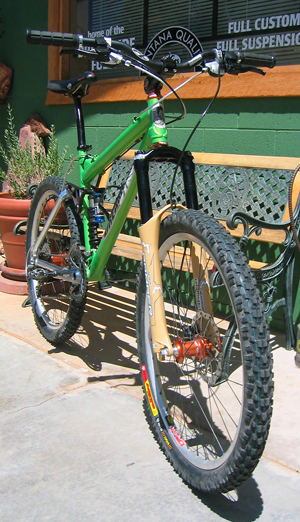
I found limits of the lighter wheelset pictured here (mango hubs, Mavic 519 rims)--a set I temporarily installed to replace those built for the Maverick experiment. I found the perfect balance of weight, rigidity and width by rebuidling the set I had used for the Maverick (the stupid Maverick 24mm axle thing required three rebuilds to get the spoke lengths right--not even Chris King knew the correct hub measurements for their own hub for the Maverick--and I ended up giving the front hub away). I used Mavic EX521 rims (see the picture below). The EX521 rims are wide and sturdy, designed to be used with rim or disc brakes for DH racing, but they are certainly light enough for All Mountain and XC work. Because the rim braking surface is machined and the alloy a tad more firm, they are stiff, look great and do not scratch as easily as the lighter XM321, which are standard rims for the Fully. The heavier 521DH rims are the same width as the XM321's, so a fat tire finds good support for tall sidewalls.
Some more good news and a follow-up warning about large rotors and quick release skewers: First, Marzocchi came out with a 20mm axle version of the AM1 for 2006! Second, anyone using a standard axle set up with rotors larger than 6" is advised to stay on top of skewer tightness before, during and after each ride. 7" or larger rotors can pull the wheel right off of the fork if the skewer is not tight. This becomes more and more an issue with heavier riders.
Standard axle King ISO front hubs work more than just fine for the Fully. I prefer a 20mm, but I am doing just fine with the standard axle now that I am resigned to it, and especially now that I have a Dreamride Mutant to fulfill the speed death wish. AM1 with standard front axle is a bit flexy and due to the air/spring suspension mixture the fork can be a bit cockeyed sitting on the floor with no rider on it. Rest assured, the fork feels and works great in use. The Maverick and Z-1 SL QR20 may have been stiffer at slower speeds, but the flex that came out of the Maverick was scary, caused by overall lightweight design. The AM-1 felt much more positive when attacking obstacles at faster speeds. This is primarily due to the feel of fork valving, not the axle. In my judgment, the flex I experienced with a standard axle was when I was pushing the bike beyond sane limits. It is not a freeride frame, so I shouldn't expect it to act like one. We have the Mutant for that sort of madness. In 2006, the Mutant uses a Z-150 FR, the Z-1 Lite or an AM1 with a 20mm axle, so the 20mm axle allows choices now in the 'zocchi line.
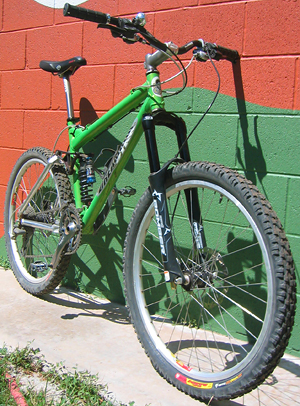
The AM-SL has become a favorite for clients in other areas of the country. It is much lighter, if you are looking to save weight on a rugged fork and still have great suspension and handling response---but it is not as plush or tuneable as the AM1, which is why I personally prefer the "1." When I test a Marzocchi fork I am reminded of just what kind of other fork crap people are buying out there. Dreamride has tested EVERY fork on the market (except new stuff by Pace in Britain--not worthy of testing from what I can see--and the Magura forks, which I don't think I should even consider due to cosmetics and weight). I am going to tell you that Lefties suck, Fox forks kinda suck (they may fix the leaky seals and complicated valving in the future if their forks take the same path as their rear shocks, which are currently the absolute very best). Rock Shox have sucked for years. Manitous are unreliable, despite the fact that the Firefly is an option (it got a low passing grade in tests here). If you want a lightER 20mm axle fork on a Fully, we now have the 2006 Z1-SL, which is incredible and suitable for the SL version of the Mutant, as well.
Some folks seem to think Marzocchi forks are overpriced (list on the AM-SL is $775), but they are still the best even with the higher price tag factored into the testing. The real question is, "Why do people fall for hyped up advertising?" A high priced marketing expert once told me to stop advertising, because, "It puts you in direct competition with liars." Advertising,"Is especially ineffective, if you want the right clients." Nuff said.
The Moots seatpost is now a stock item on the Fully for most riders: It has its own sweet soft feel and is the lightest of its kind. The clamp is flawless. It is handmade, so it costs real money, but it is truly worth the investment. Dreamride now has its own titanium risers and bar ends. The are an option on the Fully. The risers work on the Mutant.
Copyright Dreamride LLC. No material, written, graphics, or photographs on this website, may be reproduced, broadcast, published, re-written, re-edited, or re-used in any way outside of this site without written consent of Dreamride LLC and Lee Bridgers. Use of this site signifies agreement to terms of use.
